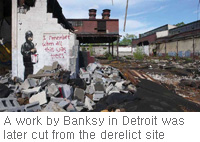 Banksy murals prove to be an attribution minefield
Banksy murals prove to be an attribution minefieldProblems arise over issues of ownership, illegality of street art and the artist’s refusal to sign works
The pitfalls of authenticating Banksy murals came into focus again last month when it was revealed that the second alleged work by Banksy to hit the streets of Liverpool in the space of three weeks was, in fact, falsely attributed.
Fans and prospective buyers turn to Banksy’s official website (banksy.co.uk) for photographic evidence of murals, and the second work in Liverpool does not appear online. However, the artist neither officially sanctions his murals online, nor signs the actual street works for fear of legal repercussions.
Pest Control, the body that has authenticated Banksy’s gallery works since 2008, states online that it “only deals with legitimate works of art and has no involvement with any kind of illegal activity”. Subsequently, the independent New York-based organisation Vermin was set up to provide certification of Banksy’s outdoor works, although Vermin’s website now appears to be defunct.
As well as the legality of painting in the street, the question of ownership is difficult. Usually, the owner of a building with a Banksy mural owns the work de facto, and so can consign it for sale (although without official authentication from the artist). It is more complicated if, for example, a local authority owns the property or the building has been abandoned, as was the case with a Banksy mural cut from a derelict site in Detroit in May 2010, and due to go on show in the city next month after a lengthy legal dispute over ownership. Artists from the non-profit space 555 Galleries and Studios removed the work from an abandoned car plant owned by Bioresource Inc, a technology company which filed a lawsuit requesting that the 8ft section of wall be returned. The case was settled last September after the gallery paid $2,500 to Bioresource. The mural, which Bioresource argued could be worth more than $100,000, is not for sale, says a gallery spokesman. It is scheduled to be permanently displayed in a 7,000 sq. ft former police station that the gallery is renovating.
The issue of ownership can also give rise to allegations of theft. In December, Leon Lawrence appeared in court accused of cutting Banksy’s Sperm Alarm, 2011, from a wall of London’s Hesperia Hotel. Lawrence, who denies the allegations and is due to stand trial in May, reportedly tried to sell the work on eBay for £17,000.
While some say that the removal of street art is stealing, others call it salvaging. Stephan Keszler, whose gallery in the Hamptons deals in Banksy murals, says many works would be destroyed if they were not removed. He says he has around ten street works, including a door from Berlin priced at $200,000 and a piece from New Orleans priced at $70,000. Keszler was fiercely criticised last August when his gallery, in collaboration with London’s Bankrobber Gallery, brought two public murals by Banksy, neither of which was authenticated, from the West Bank to the US. He says he did not acquire Stop and Search and Wet Dog, both 2007, from the building’s owners, and that they had already been excavated when he took them. Keszler now plans to lend the works to an East Coast museum (see box, right).
The lack of an official authentication process for Banksy’s street works means that auction houses rarely sell them. Gareth Williams, a street art specialist for Bonhams, says: “We don’t handle Banksy’s street pieces as we do not condone their removal. We respect the artist’s belief that these works have been executed for the public to view and appreciate, and understand his unwillingness to commodify them.” Williams says that Bonhams only sells works authenticated by Pest Control, as “potential buyers need to be confident that what they are buying is an authentic work”.
The street artist Ben Eine, who has worked with Banksy for years, says that murals should be left in situ. “The street work we do is not painted to be sold a few years later,” he says. “This is one reason I don’t sign my street stuff, and, like other artists, would never authenticate it—it’s not made to be sold, but to be enjoyed.” Eine is, however, philosophical about the sale of street works: “As with everything of value, someone will want it and someone is always ready to make a profit—that’s life.”
 Banksy murals prove to be an attribution minefield
Banksy murals prove to be an attribution minefield